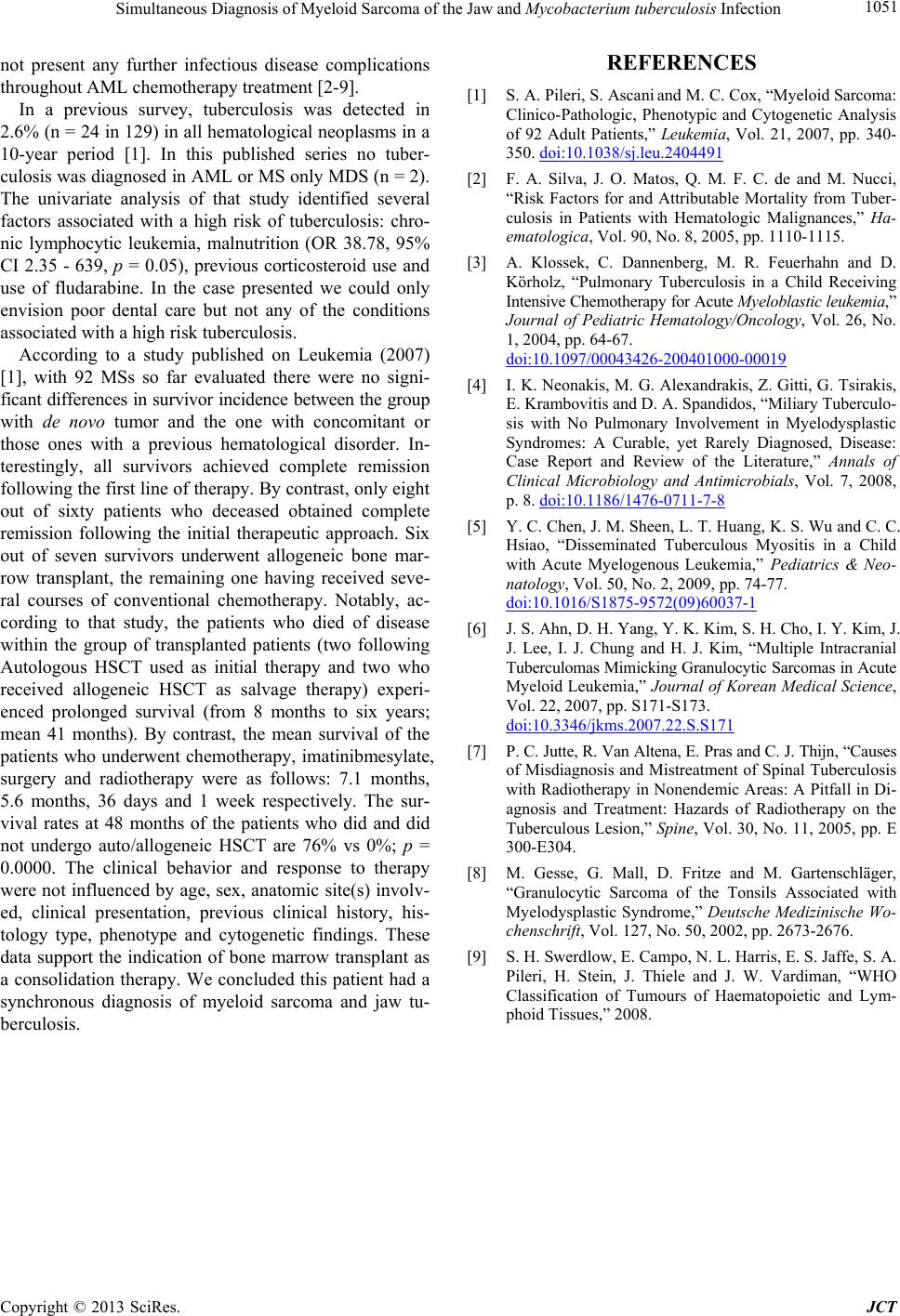
Simultaneous Diagnosis of Myeloid Sarcoma of the Jaw and Mycobacterium tuberculosis Infection
Copyright © 2013 SciRes. JCT
1051
not present any further infectious disease complications
throughout AML chemotherapy treatment [2-9].
In a previous survey, tuberculosis was detected in
2.6% (n = 24 in 129) in all hematological neoplasms in a
10-year period [1]. In this published series no tuber-
culosis wa s diagnosed in AML or MS only MD S (n = 2) .
The univariate analysis of that study identified several
factors associated with a high risk of tuberculosis: chro-
nic lymphocytic leukemia, malnutrition (OR 38.78, 95%
CI 2.35 - 639, p = 0.05), previous corticosteroid use and
use of fludarabine. In the case presented we could only
envision poor dental care but not any of the conditions
associated with a high risk tuberculosis.
According to a study published on Leukemia (2007)
[1], with 92 MSs so far evaluated there were no signi-
ficant differences in survivor incidence between the group
with de novo tumor and the one with concomitant or
those ones with a previous hematological disorder. In-
terestingly, all survivors achieved complete remission
following the first line of therapy. By con trast, only eight
out of sixty patients who deceased obtained complete
remission following the initial therapeutic approach. Six
out of seven survivors underwent allogeneic bone mar-
row transplant, the remaining one having received seve-
ral courses of conventional chemotherapy. Notably, ac-
cording to that study, the patients who died of disease
within the group of transplanted patients (two following
Autologous HSCT used as initial therapy and two who
received allogeneic HSCT as salvage therapy) experi-
enced prolonged survival (from 8 months to six years;
mean 41 months). By contrast, the mean survival of the
patients who underwent chemotherapy, imatinibmesylate,
surgery and radiotherapy were as follows: 7.1 months,
5.6 months, 36 days and 1 week respectively. The sur-
vival rates at 48 months of the patients who did and did
not undergo auto/allogeneic HSCT are 76% vs 0%; p =
0.0000. The clinical behavior and response to therapy
were not influenced by age, sex, anatomic site(s) involv-
ed, clinical presentation, previous clinical history, his-
tology type, phenotype and cytogenetic findings. These
data support the indication of bone marrow transplant as
a consolidation therapy. We concluded this patient had a
synchronous diagnosis of myeloid sarcoma and jaw tu-
berculosis.
REFERENCES
[1] S. A. Pileri, S. Ascani and M. C. Cox, “Myeloid Sarcoma:
Clinico-Pathologic, Phenotypic and Cytogenetic Analysis
of 92 Adult Patients,” Leukemia, Vol. 21, 2007, pp. 340-
350. doi:10.1038/sj.leu.2404491
[2] F. A. Silva, J. O. Matos, Q. M. F. C. de and M. Nucci,
“Risk Factors for and Attributable Mortality from Tuber-
culosis in Patients with Hematologic Malignances,” Ha-
ematologica, Vol. 90, No. 8, 2005, pp. 1110-1115.
[3] A. Klossek, C. Dannenberg, M. R. Feuerhahn and D.
Körholz, “Pulmonary Tuberculosis in a Child Receiving
Intensive Chemotherapy for Acute Myeloblastic leukemia,”
Journal of Pediatric Hematology/Oncology, Vol. 26, No.
1, 2004, pp. 64-67.
doi:10.1097/00043426-200401000-00019
[4] I. K. Neonakis, M. G. Alexandrakis, Z. Gitti, G. Tsirakis,
E. Krambovitis and D. A. Spandidos, “Miliary Tuberculo-
sis with No Pulmonary Involvement in Myelodysplastic
Syndromes: A Curable, yet Rarely Diagnosed, Disease:
Case Report and Review of the Literature,” Annals of
Clinical Microbiology and Antimicrobials, Vol. 7, 2008,
p. 8. doi:10.1186/1476-0711-7-8
[5] Y. C. Chen, J. M. Sheen, L. T. Huang, K. S. Wu and C. C.
Hsiao, “Disseminated Tuberculous Myositis in a Child
with Acute Myelogenous Leukemia,” Pediatrics & Neo-
natology, Vol. 50, No. 2, 2009, pp. 74-77.
doi:10.1016/S1875-9572(09)60037-1
[6] J. S. Ahn, D. H. Yang, Y. K. Kim, S. H. Cho, I. Y. Kim, J.
J. Lee, I. J. Chung and H. J. Kim, “Multiple Intracranial
Tuberculomas Mimicking Granulocy tic Sarcomas in Acute
Myeloid Leukemia,” Journal of Korean Medical Science,
Vol. 22, 2007, pp. S171-S173.
doi:10.3346/jkms.2007.22.S.S171
[7] P. C. Jutte, R. Van Altena, E. Pra s and C. J. Thijn, “Cause s
of Misdiagnosis and Mistreatment of Spinal Tuberculosis
with Radiotherapy in Nonendemic Areas: A Pitfall in Di-
agnosis and Treatment: Hazards of Radiotherapy on the
Tuberculous Lesion,” Spine, Vol. 30, No. 11, 2005, pp. E
300-E304.
[8] M. Gesse, G. Mall, D. Fritze and M. Gartenschläger,
“Granulocytic Sarcoma of the Tonsils Associated with
Myelodysplastic Syndrome,” Deutsche Medizinische Wo-
chenschrift, Vol. 127, No. 50, 2002, pp. 2673-2676.
[9] S. H. Swerdlow, E. Campo, N. L. Harris, E. S. Jaffe, S. A.
Pileri, H. Stein, J. Thiele and J. W. Vardiman, “WHO
Classification of Tumours of Haematopoietic and Lym-
phoid Tissues,” 2008.